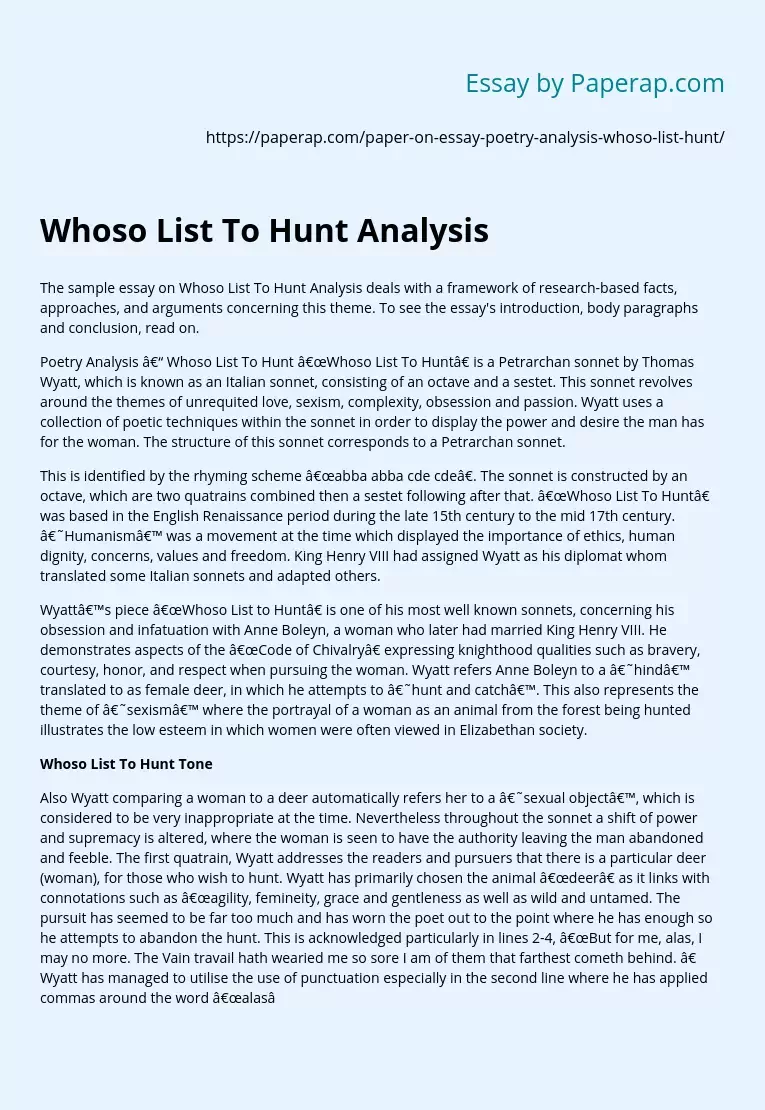The sample essay on Whoso List To Hunt Analysis deals with a framework of research-based facts, approaches, and arguments concerning this theme. To see the essay’s introduction, body paragraphs and conclusion, read on.
Poetry Analysis – Whoso List To Hunt “Whoso List To Hunt” is a Petrarchan sonnet by Thomas Wyatt, which is known as an Italian sonnet, consisting of an octave and a sestet. This sonnet revolves around the themes of unrequited love, sexism, complexity, obsession and passion. Wyatt uses a collection of poetic techniques within the sonnet in order to display the power and desire the man has for the woman.
The structure of this sonnet corresponds to a Petrarchan sonnet.
This is identified by the rhyming scheme “abba abba cde cde”. The sonnet is constructed by an octave, which are two quatrains combined then a sestet following after that. “Whoso List To Hunt” was based in the English Renaissance period during the late 15th century to the mid 17th century.
‘Humanism’ was a movement at the time which displayed the importance of ethics, human dignity, concerns, values and freedom. King Henry VIII had assigned Wyatt as his diplomat whom translated some Italian sonnets and adapted others.
Wyatt’s piece “Whoso List to Hunt” is one of his most well known sonnets, concerning his obsession and infatuation with Anne Boleyn, a woman who later had married King Henry VIII. He demonstrates aspects of the “Code of Chivalry” expressing knighthood qualities such as bravery, courtesy, honor, and respect when pursuing the woman.
Wyatt refers Anne Boleyn to a ‘hind’ translated to as female deer, in which he attempts to ‘hunt and catch’. This also represents the theme of ‘sexism’ where the portrayal of a woman as an animal from the forest being hunted illustrates the low esteem in which women were often viewed in Elizabethan society.
Whoso List To Hunt Tone
Also Wyatt comparing a woman to a deer automatically refers her to a ‘sexual object’, which is considered to be very inappropriate at the time. Nevertheless throughout the sonnet a shift of power and supremacy is altered, where the woman is seen to have the authority leaving the man abandoned and feeble. The first quatrain, Wyatt addresses the readers and pursuers that there is a particular deer (woman), for those who wish to hunt. Wyatt has primarily chosen the animal “deer” as it links with connotations such as “agility, femineity, grace and gentleness as well as wild and untamed. The pursuit has seemed to be far too much and has worn the poet out to the point where he has enough so he attempts to abandon the hunt. This is acknowledged particularly in lines 2-4, “But for me, alas, I may no more. The Vain travail hath wearied me so sore I am of them that farthest cometh behind. ” Wyatt has managed to utilise the use of punctuation especially in the second line where he has applied commas around the word “alas” then ending the sentence with a full stop giving the impression that he is breathless and expressing a fatigue status.
Another technique used was the use of an assonance, repetition of vowel sounds, which is displayed in line 3, “vain travailed hath wearied me” once again depicting the hunter’s fatigue by slowing down the line. The poet also believes that many of the suitors seem to be ahead of him (including Henry VIII) and that he is the last of the pursuers, “that farthest cometh behind”. The tone of the first quatrain is quite negative as it depicts a sad and pessimistic attitude. In the second quatrain, the narrator warns the other suitors of the futility of the hunt.
The narrator in this stanza shows strong obsession and passion, demonstrating strong aspects of ‘male desire’. The second quatrain begins with the word “yet” highlighting the ‘shift’ from the previous quatrain. He has just decided to give up on the hunt nonetheless he fails to withdraw his mind from the deer. This shows that even though he feels hopeless and unattainable this doesn’t stop him from feeling the way he feels about the woman. The poet in lines 5-6 cannot take his fatigued mind off the ‘deer’ as she continues to flee. my wearied mind Draw from the deer, but as she fleeth afore,”. These lines signify his ‘obsession’ of possessing his prey. The use of the poetic term ‘consonance’, repetitions of non-vowel sounds, in line 6, “Draw from the deer” expresses the reoccurring longing desire and passion for the deer (woman). Another instance in which consonances are used, “as she fleeth afore, Fainting I follow. I leave off therefore”. In this line there is an unremitting repetition of the letter “F” which gives a great indication that the hunter is out of breath and exhausted.
When she flees, it quotes, “fainting I follow”. He can only barely catch up to the wind that follows behind her, so he realises here that the chase is futile. He apprehends the fact that the deer is not welcoming his affection, which refers back to the theme of “unrequited love”. Wyatt in addition introduces a second ‘metaphor’, “wind” in which he uses to describe the woman. The “wind” symbolises agility, freedom and is impossible to capture. The first octave makes out that this was all a wasted hunt, and that the poet is officially unsuccessful.
In the closing sestet, the hunter addresses the other suitors who are determined to capture her that they have absolutely no chance and warns them that they’ll suffer deep consequences if they attempt to do so and will spend their after time in vain. In the 11th line, the poet elaborates that the hind is wearing a diamond necklace or collar of some sort with the words engraved in it quoting, “Noli me tangere, for Caesar’s I am” translated to “touch me not for I am Caesar’s”.
Thus warning all hunters that this particular hind is under ownership of royalty, and if captured, must immediately be set free. The deer also forewarns the hunters that although she may appear tame, capturing her is dangerous and perilous, for as she is wild. The tone expressed throughout the sestet is “disappointment, frustration and dissatisfaction. ” Throughout the entire sonnet, a shift of power has been experienced, as clearly the hind (woman) takes place in having authority over the men.
This sonnet expresses “unconscious values of society” and is considered to be a very political sonnet during that period as the “men were considered to be active whilst the women were passive”. In conclusion, “Whoso List To Hunt” by Thomas Wyatt, a Petrarchan sonnet, is deemed to have been a political sonnet revolving around human values, power and statuses. The sonnet comprises of multiple themes such as unrequited love, sexism, complexity, obsession and passion. As well as numerous poetic techniques such as “metaphors, repetition, emotive language and symbolism” in order to help convey messages throughout the sonnet.
Whoso List To Hunt Analysis. (2019, Dec 06). Retrieved from https://paperap.com/paper-on-essay-poetry-analysis-whoso-list-hunt/

